Being vocal about things that affect me is a compulsion for me, and it’s how I figure out my own thoughts. I have also been silenced a lot in the past on speaking out on things, so this feels like a welcome release.
Staying relevant with the hyper-changing times is one thing that’s always on Mira Malhotra’s mind, and she is walking the talk by constantly focusing on some of the most pressing social and political issues of our times through her voice and her work. Mumbai-based graphic designer, visual artist, and illustrator, Mira has emerged as an important voice in the Indian design/illustration scene.
Her work often comes peppered with humour, satire, her deep love for color, and inspiration from objects around her. She has a keen interest in the DIY culture, feminism, mental health, Indian culture, and independent music, among other things. It’s not difficult to find these interests often reflect in her work, especially in her personal projects.
Mira studied BFA in Illustration at Mumbai University and then did a Master’s in Graphic Design at National Institute of Design (NID). She is also a founding member of Kadak, a fantastic global collective of South asian women graphic artists. She runs her independent design studio in Mumbai called Studio Kohl.
We try to know more about Mira’s work and life in the last few years for our first interview of 2020. Read below:
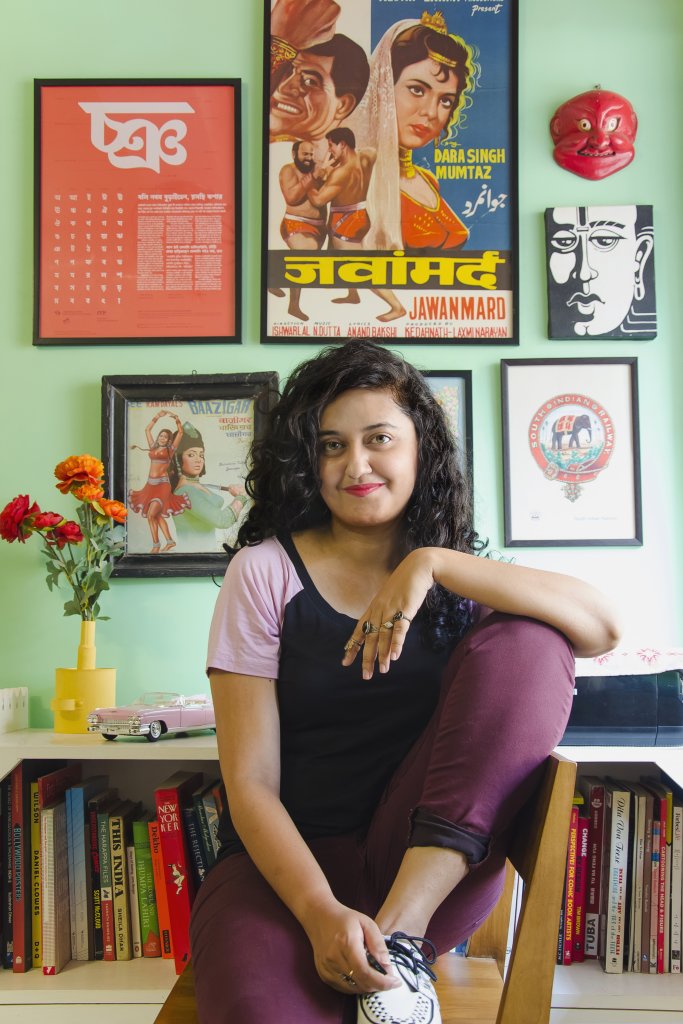
Mira Malhotra
You have been quite involved in and vocal about some of the political/social issues that we are facing right now. How do you balance it with your creative work? Does it end up draining your energy?
Being vocal about things that affect me is a compulsion for me, and it’s how I figure out my own thoughts. I have also been silenced a lot in the past on speaking out on things, so this feels like a welcome release. Earlier, a great deal of my time was being spent on thinking about things that were wrong in the places I was working at, like harassment and sexist behaviour, but I could never talk about it. I was always wondering if I was wrong and if the more equitable workplace of my dreams was a far off reality. That would drain my energy.
At the same time, I was still putting everything into my creative work. Incidentally, none of my colleagues at any given time had any issues with my work ever. I showed up; I gave in my 100%; I went that extra mile; and I am usually quite obsessive when it comes to my work.
The issue was that I was a woman. Many bosses want to hire you because you are talented, but if you reach a certain point, you are either a threat, or, no matter how high the quality of your work is, they can’t un-see your gender and it colours the way they see your work. Male colleagues have actually openly voiced their issues with me being better at my work, even if there were no promotions or pay hikes on the horizon. How is it okay to talk like that? Why should there be a limit to what I can do? I tried to manage all this while doing my work but I got silenced a lot. Now that I can finally speak openly, it feels like redemption. I finally have my chance to say things and there are a lot of people ready to hear it.
This has also started getting reflected in your work I guess. You have been working on quite a few social change projects.
Yes, we have been actively doing social change projects. I might not always be doing that work because of the bread and butter factor, but these projects do help me learn a lot besides being deeply satisfying. Every time I go into a meeting with a great social good client, I leave thinking, ‘Wow, so there are solutions to problems I thought were unsolvable’. As a very cynical person, this means a great deal to me. It gives me hope.
The insights are great, and I want to share them through my work. I can’t bear it if my work is just good looking – though I am often accused of that (laughs). Each time we are able to create more powerful work, we are articulating the problem better. Secondly, I just feel it’s needed right now. In India, there aren’t enough voices in design that are talking about the fundamental and necessary topics like mental health and gender. Luckily, there are many within illustration.
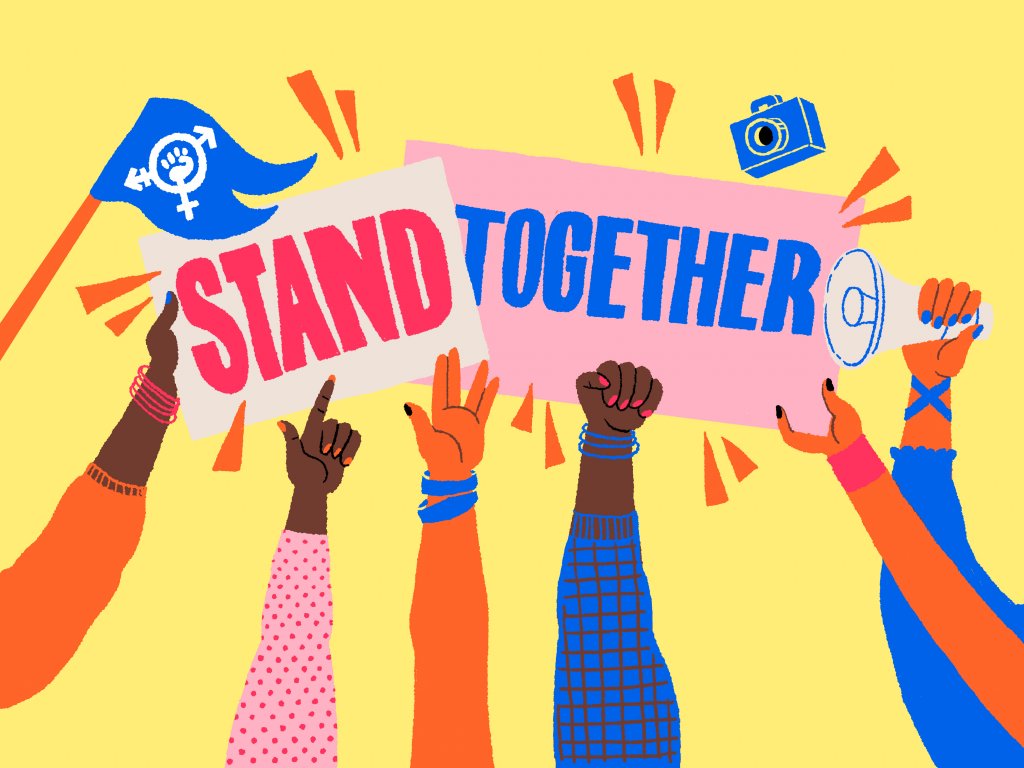
International Women’s Day ’19 | Snapchat
Privilege remains privilege unless challenged by an experience that puts the privileged in a position to understand oppression. Then for those who are already willing and want to change, design needs to simplify information.
What is the Indian design scene missing, according to you?
I think designers here are focusing more on the skills, aesthetics, or technical aspects of work. In most cases, the work is not being looked at with a viewpoint. Seeing the work from a lens is important. For me, I‘ve found the gender lens I get from feminism is important. The mental health lens is important. The feminist lens is not only about gender, but takes into account many other marginalizations within it, which allows for a more holistic understanding of what you’re doing and who it’s going to affect in the first place. I am always trying to figure out my own stance on certain ideas.
I also feel that many times designers undervalue the power of their profession. I recently heard on a podcast that designers should be humble as design is not very important when it comes to solving problems, and that law and policy for example makes more of a difference. The justification for this view was that design exists in silos and isn’t making much of an impact because it’s driven by big egos in a small pond. However true that is, it cannot be the reason why our work should be any less powerful, especially if you’re a communication designer. For an audience, the first step in figuring out if a problem is even a problem is something that can be accomplished through communication design. That is a very big deal. Communication is extremely important to bring about awareness. Once that is established, then bringing in legal solutions, actioning public policy, etc. are even possible. One of the reasons why we are seeing such a shocking display of arrogant power from the state is because of this ‘chronology’ – the media has been hijacked first with a narrative that’s extremely biased and or even complete lies, and this creates the groundwork for anti-communal forces to come in and wreak havoc.
The other important aspect of design (as well as art) is to create experiences that are new. Privilege remains privilege unless challenged by an experience that puts the privileged in a position to understand oppression. Then for those who are already willing and want to change, design needs to simplify information. For example, if a broader mass of people have to understand the Trans Bill, design can help them understand that experience to show them why it’s dehumanising and why it’s important to fight against it. For those who understand the importance of this problem, they need to know how to put into place a solution. Design can help bridge this gap we see – between academics, advocates, researchers, intellectuals and the masses.
Design in certain circles India also operates with a bit of snobbery. This was evidenced by some odd criticism we received on our zine ‘Unfolding the Saree’. If a material we use works, why should it not be used even if it’s cheap? And furthermore, what if the “cheapness” of the material is actually part of or strengthens the commentary we are trying to make? Design has to be led by its purpose, and if it has its purpose, the material will follow. We don’t want to design for the privileged always.
Lastly, I see two camps in design in India. One is the form-follows-function camp that has great intent but misses out on aesthetic value, ultimately making work that’s less engaging and is adopted less. The second camp dismisses the functional aspects of design for something that’s ultimately very good looking or trend-driven and its value ends there. At Studio Kohl, the aim is to do both at a higher and higher level each time we get a chance. There’s a lot of useless products we don’t need out there in the market. But they sell, a lot, because profit-driven companies know how to make these “things” so appealing to us. We can re-appropriate some of these tricks with design that drive these sales and use them for social good projects. At least that’s how I see us working five years from now. We want to make social good entertaining, enjoyable, engaging, and accessible.
There are so many issues plaguing us today in general. How do you pick your battles?
I think everyone is built to handle certain battles, just like how we choose different careers and partners in life. We should always strive to know ourselves and play to our strengths. I tend to talk about things that I know well about. For example, I keep talking about gender. If I don’t have much knowledge and interest in a subject, I won’t be able to do justice to the project I am working on. Of course, you can always find experts to collaborate with when required.
Overall, your artistic style should be governed by what you want to say in your heart and from your life experience.

Created for Helter Skelter’s Anthology of New Writing – ‘Dissent’
When I work with other people, I feel an overwhelming sense of responsibility towards them and that burns me out. I am much freer when I work completely on my own. I care a lot about what others feel and think, and that gives me anxiety. And of course, the people I work with are not creating this pressure, I am putting this pressure on myself.
Your work has always had this fierce originality. You have taken many elements of Indian culture without stereotyping them. Is that something you are still very conscious about?
Yes, I am. I have to constantly walk this line of not appropriating the Indian elements in my work. The more I go along this path, the more I conscious I am about this. As a kid, I was in awe of art made by white people, and then I came back to find my own roots. I did realise that at some point, I was appropriating stuff made by poorer sections of society within India and I had to review my actions.
A lot of what I hope is originality comes again from the lens that I have to stop aping what the western world is offering us. I get a lot of inspiration from the approach taken by Iranian, Russian, and Japanese graphic designers. They are creating work silos and thus their work isn’t really corrupted by the overdose of inspiration online. They are hardly looking at the West at all, and that’s why they are fiercely original. There is this Iranian graphic designer I really like – Homa Delvaray. Her work is so contemporary and original, and uses Iranian culture for inspiration. So I believe that we should be using our own culture, and there’s enough of it.
How’s the balance between personal projects and professional work going?
As the work grows and especially ever since GST started, maintaining this balance has been harder. I have this paranoia about doing the billings perfectly. There is just too much paperwork now. Then we also have to promote our work which means doing social media, giving interviews, regularly updating our website etc. It all bites into your time. Now we are trying to hire an administrative person though, and that should help.
We have had 4-5 zines on the back-burner for three years now. Some of them need hardcore writing and we don’t have the time to hire specific writers for them. We also have some funny zines we were working on including one about haikus on the digital world which needs some design work.
Personal projects are very important for me. I feel that you cannot pave the way for good alliances and innovative projects unless you do self-initiated projects. Personal projects allow us to present our best work and help demonstrate our best capabilities – this will then attract clients who are really on our wavelength, so we can make great work together. I call ‘Unfolding the Saree’ zine my much larger visiting card, because it demonstrates the kind of work we can do in the best way possible.
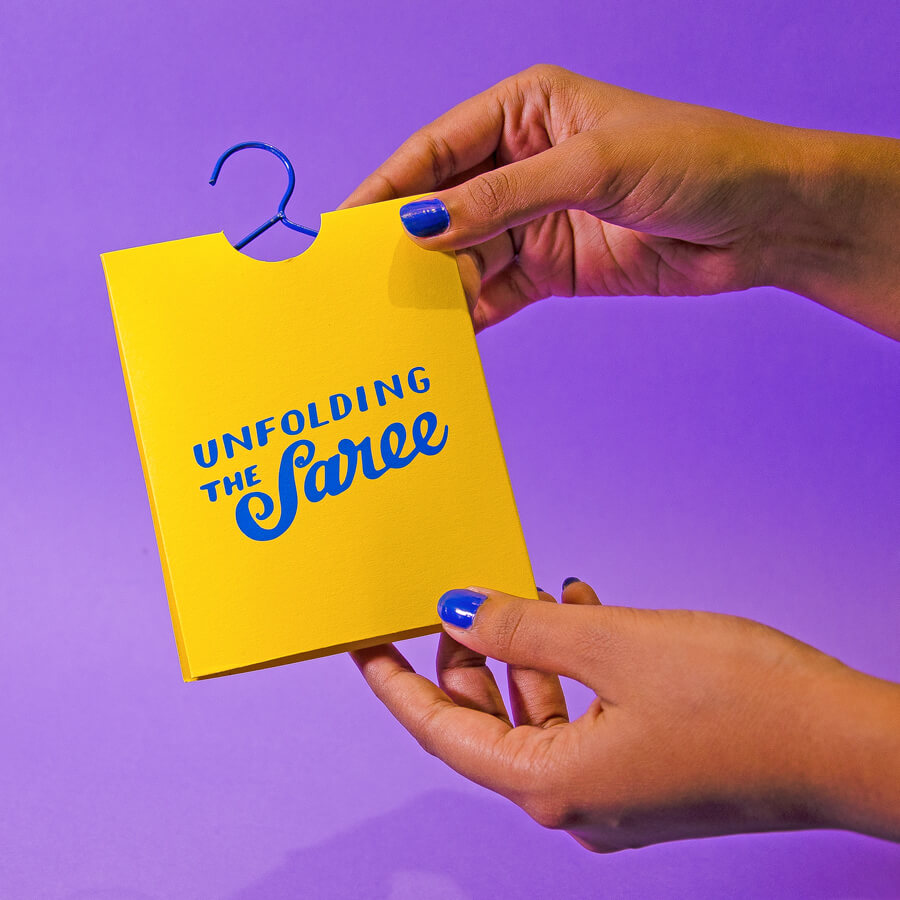
Unfolding The Saree
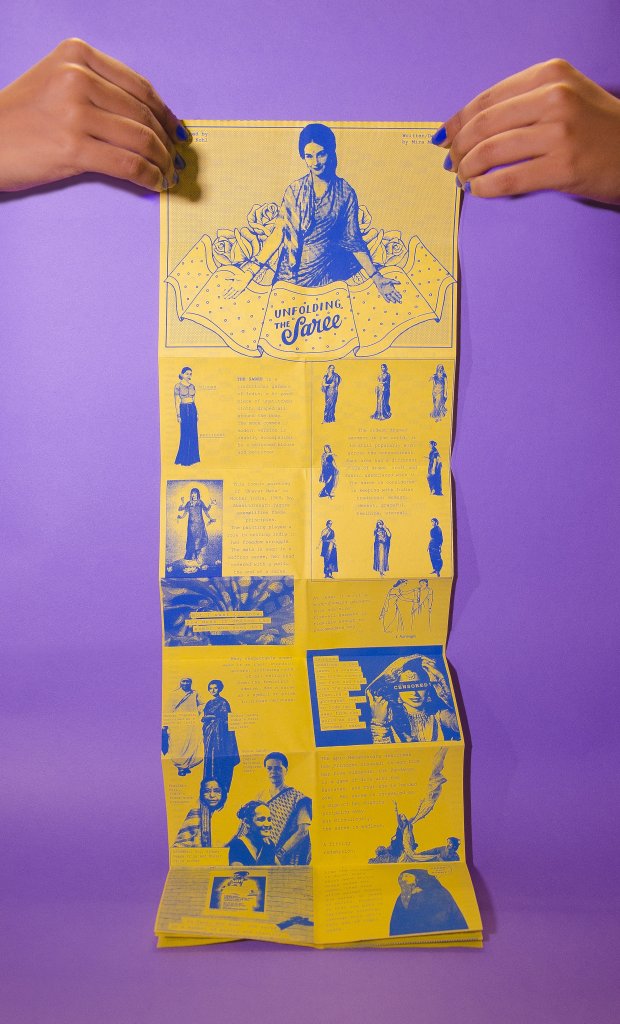
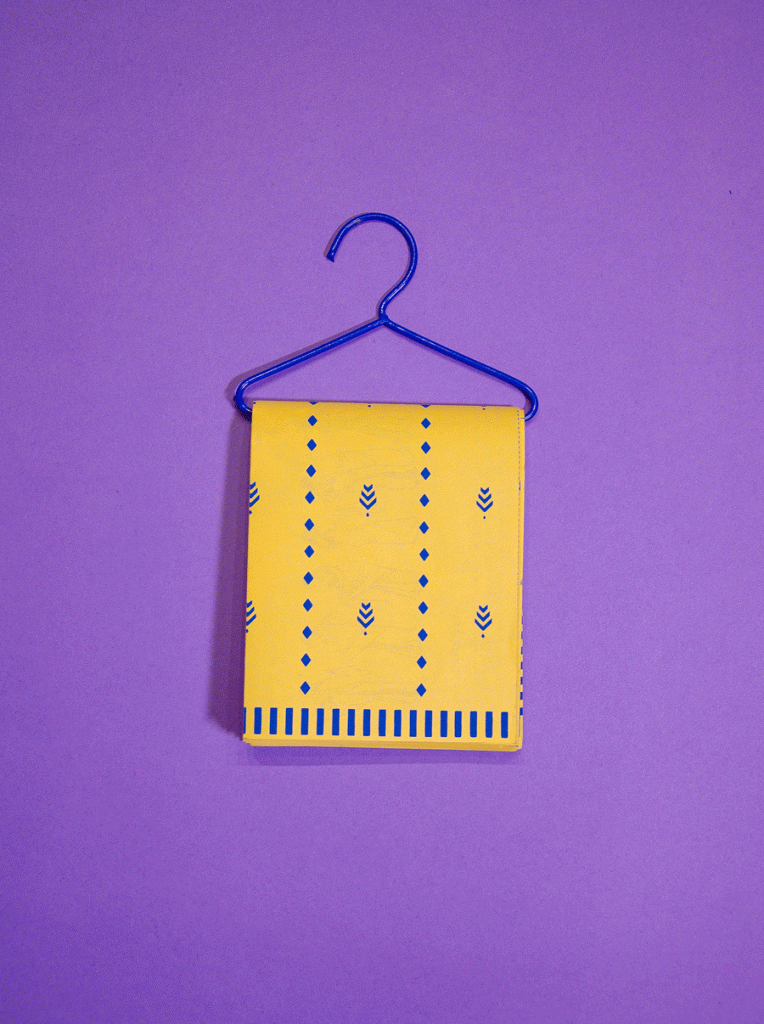
You have spoken about experiencing a burnout last year. Could you tell us a bit more about it?
I kind of burnt out when we launched the kickstarter for Kadak Collective’s The Bystander Anthology. I was also going through some personal things at the time.
When I work with other people, I feel an overwhelming sense of responsibility towards them and that burns me out. I am much freer when I work completely on my own. I care a lot about what others feel and think, and that gives me anxiety. And of course, the people I work with are not creating this pressure, I am putting this pressure on myself.
I also tend to involve myself in thousands of projects. Over time, you get annoyed with smaller projects as they don’t pose enough challenge, so you want to do something big.
So what did you do when you experienced this?
I read a lot of articles, listened to podcasts, and watched videos about burnouts! And what seemed to be the general verdict was that you needed to focus on a few things. You are probably focused on too many things when you experience a burnout.
And it was true in my case. I would get overwhelmed with people calling me constantly about work and other stuff. Yes, there is something to gain from participating in those conversations, but you have to draw your boundaries. I have now removed myself from various Whatsapp groups which weren’t adding any value to my life. I have to preserve myself and not think so much about what other people think. Singularity is what I missed the most. I am a very distracted person in general and have too many responsibilities, so focusing on few things is especially important for me.
I also realised automating some stuff helps. For example, we created this Press Kit for Kadak and whenever people asked us the same questions, we would just send this to them instead of answering over and over again.
Sometimes, a bad client can burn you out. That’s why we prefer to start with a small job with someone new before moving onto a bigger project that requires more commitment and time. Of course, this means saying no sometimes. So you have to radically change your thinking to do all this.
Another thing I learnt from the Creative Pep Talk podcast by Andy J. Miller was to think about the year that went by and look at the things that got you eyeballs and made life easier for you. Basically, play to your strengths. An additional reason for my burnout was that I was focusing too much on my weaknesses and trying to be good at things I wasn’t good at.
How does social media impact you overall? How do you usually feel when you see other people’s work there?
I love the pre-social media internet where I could just look at sites and learn something new. There was a way you could have a limit to what you were seeing as there was no concept of unlimited feed, likes, social approval, and acceptance.
I am not at all oblivious or immune to the bad/negative effects social media can have. When you see other people’s work, you feel ‘why can’t I do this too?’. It causes obsessive anxiety. We don’t even notice the time, resources and sometimes, privilege involved in some of those projects we see on social media. I do try to remind myself of that and prioritise accordingly.
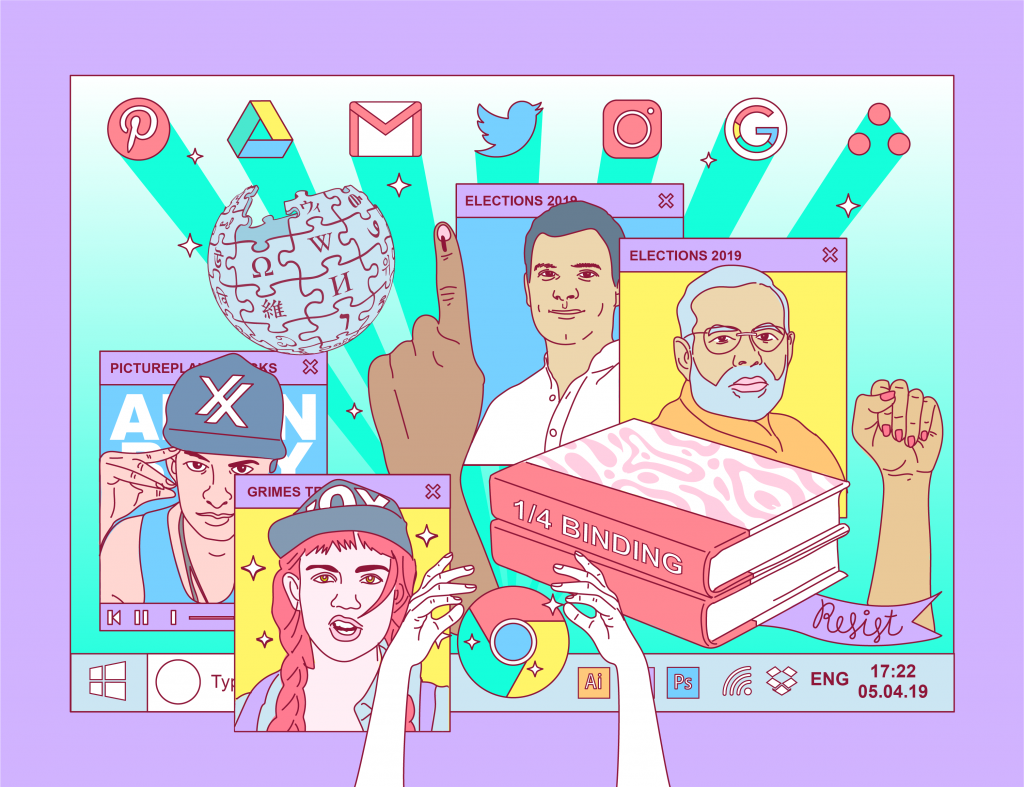
Illustration for AIGA Eye on Design magazine
I do think there is some value in just immersing yourself in whatever you are doing, even if you don’t feel like it. The ‘aha’ moment comes from complete involvement and immersion into what you are doing. You have to set that ground and be in a situation which leads to creative behaviour. This has really worked for me.
How do you feel about getting reactions to your own work on social media?
It is quite important for me. Because I am independent, I have to stay relevant to survive. Social media is not the only barometer, but we often mistakenly believe that it is. You get an instant opinion on the quality of your work and you can get confused about what that means in terms of its viability. If I am posting something, I want to know why it did or did not get attention.
But there are so many factors to this. If you put up free content, like comics for example, your content is bound to be very popular vis-à-vis mostly posting about the client work you are doing. I don’t put too much backend stuff, just the projects I am working on. It’s a celebration of the work. I have a decent following, but it’s not always easy to not understand the gap between what you are offering and what people want.
How does collaboration work for you? Is it hard for you to share your vision for a project with the people you need to collaborate with?
By default, when I am talking about a project, I usually create mock-ups or drawings to back it up. Whoever might be involved in that project would get some indication about my vision through that.
Collaboration is tough though. In some cases, I feel that someone might hijack my vision or I might have to deal with a difficult person. For example, I met up with a potential collaborator regarding a zine we were working on, and I realised that the whole concept of the zine changed during the meeting and went down a path I didn’t intend. I want to be open to other ideas but not at the cost of the original idea and motivation behind the zine.
Collaborations are harder when you are working on a niche project. For social change projects, I can’t trust just anyone with it. We need someone who can do it sensitively, so we have to vet the person carefully. There are a lot of risks involved with it.
What I usually try to do is find people in the industry who are like me in some ways and then find resources through them. That makes the process of collaboration slightly easier.
What is your creative process like? Do you believe in an ‘aha’ moment when it comes to ideas and inspiration?
It used to be about waiting for inspiration to strike. While I was in NID, they used to talk about having a process, but I didn’t really believe in it that time. However, now I do think there is some value in just immersing yourself in whatever you are doing, even if you don’t feel like it. The ‘aha’ moment comes from this complete involvement and immersion into what you are doing. You have to set that ground and be in a situation which leads to creative behaviour. This has really worked for me.
Usually when it comes to concepts and ideas, I am fairly fast and have only gotten better over the last 14 years of my career. However, I need to focus on improving my skills now. I feel I haven’t progressed much skill-wise, and it’s something I regret. I also want to increase the scale of my work. It’s easier for me to do idea-based projects but if I have to do an exhibition of my work, the scale of that would scare me.
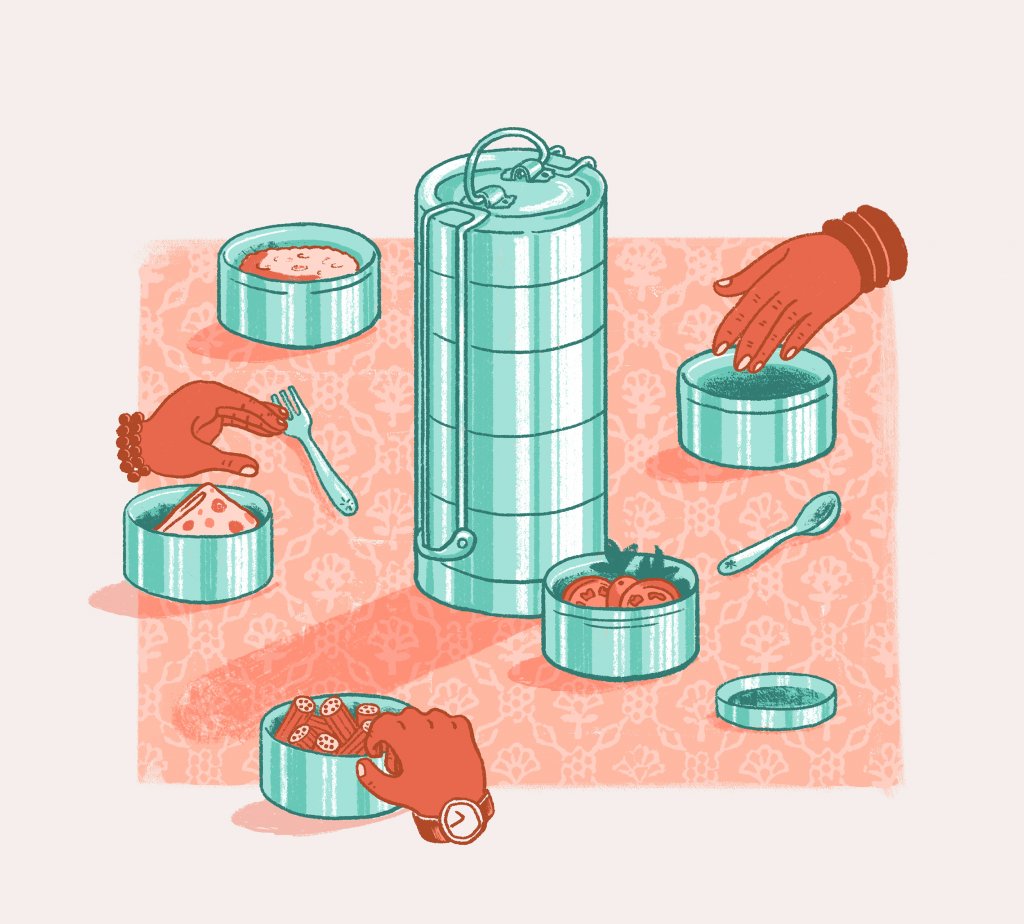
7 of 70 Words / British Council India
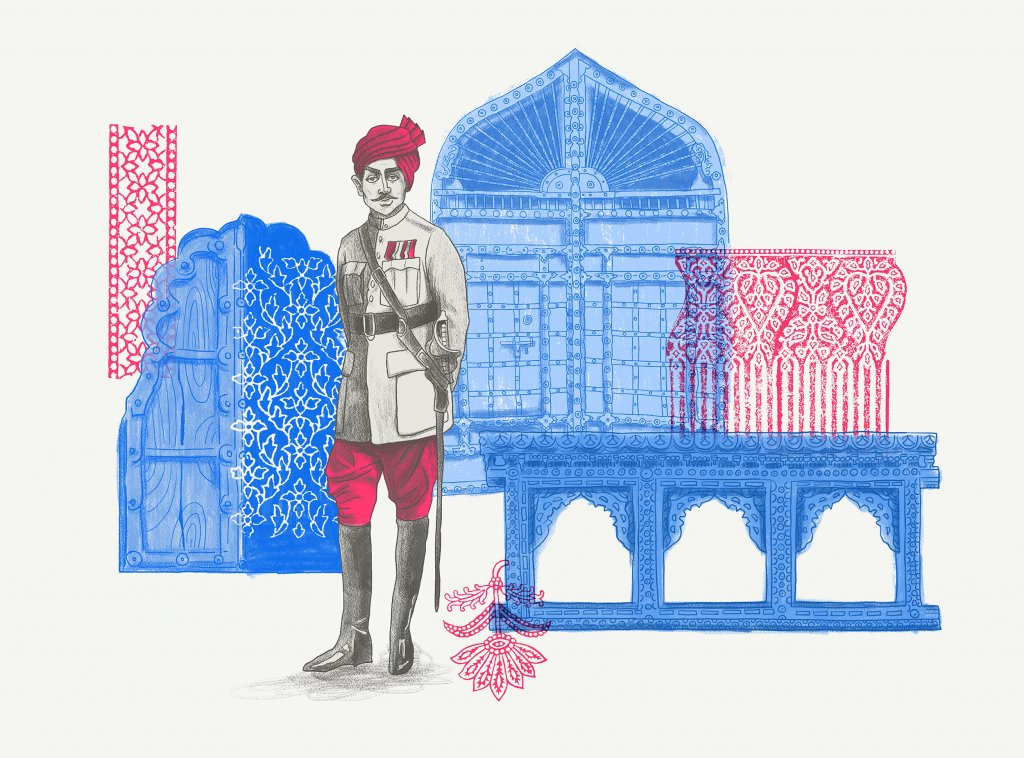
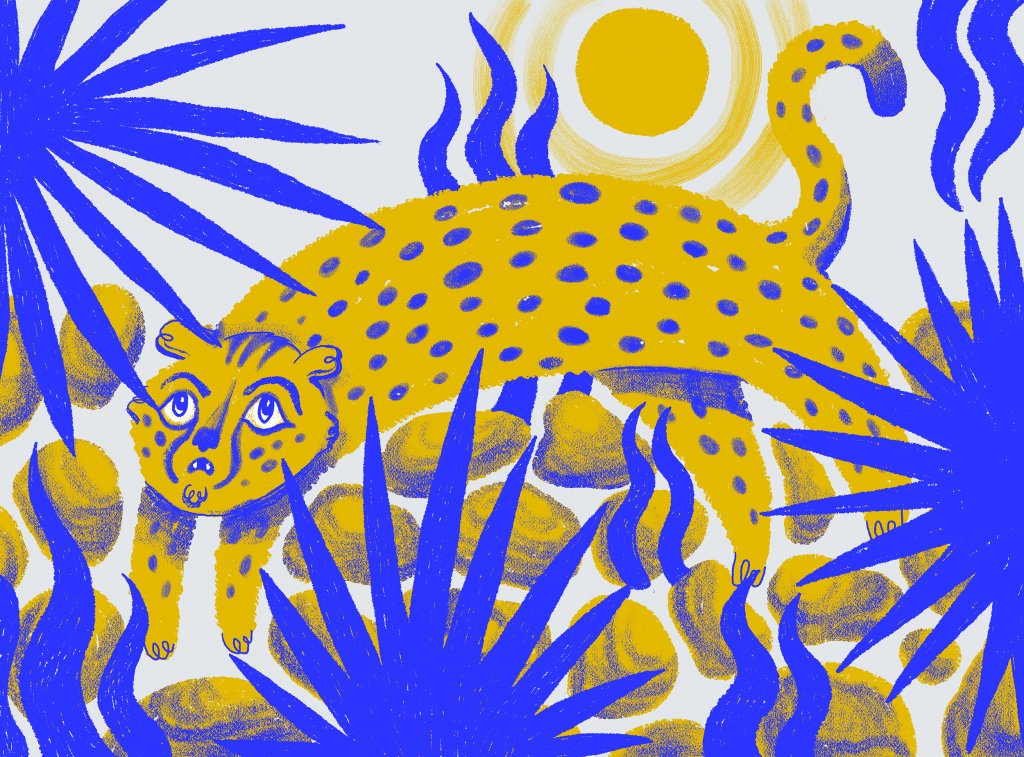
I can especially relate to the experiences of young women in design studios and ad agencies. I was shut up for being honest and now people are looking up to me because of that honesty. I want them to be bold. If more women raise their voice, things will change. We need to build a community of women who don’t feel scared. We have seen through the current protests in India that women are a formidable force, and their focus is on community.
How do you define success as a studio?
One of the ways is to ask myself if I am doing the kind of work I want to do. I know it might sound like a very privileged standpoint, but I feel we should be able to enjoy the work we are doing even in the capitalist structure. How do you work in a way that brings you joy and some satisfaction? I am also interested in doing something for the industry, having a point of view that I feel is missing and being successful in that.
Another thing is relevance. I want to stay relevant as a designer. How do you calculate that? Are you relevant for six months? Or for a lifetime? You cannot be relevant 100 percent of the time as that’s tiring. Sometimes, I feel I talk about big stuff but what we are doing is still small, and I keep apologising for it. But I also think it’s in line with what it could be in the future. There is value in having a vision. People get carried away by short bursts of fame. The trick is to do the marathon and not the sprint, and you can plot out smaller victories on the timeline. I don’t know what I’ll be in the next twenty years but I have some semblance of it.
In the last few years, we have had a lot of social good projects. We try to work on these projects with deep understanding, and also try to push them as “mainstream” products or ideas. I might have dropped some of these projects if my focus was just money, but I find a lot of value in them and therefore, continue to build on this. My goal right now is to make this kind of work relevant and popular. That has a lot of power. It’s amazing to see a big brand taking up a social cause, whatever their ultimate agenda might be. Like how Whisper did that ‘Don’t touch the pickle’ campaign and it helped change things. I’m not a purist in my approach in this regard. If a brand wants to make money and can merge it with doing something good, why not! Over the long haul, I do hope to bring this to my work – the ‘sales-worthiness’ of commercial/capitalism into the social space.
A lot of young designers/illustrators look up to you and your work. Do you feel burdened by it in some way?
I love doing that. I want to show young designers that they can do so much more.
I can especially relate to the experiences of young women in design studios and ad agencies. I was shut up for being honest and now people are looking up to me because of that honesty. I want them to be bold. If more women raise their voice, things will change. We need to build a community of women who don’t feel scared. We have seen through the current protests in India that women are a formidable force, and their focus is on community.
If there’s a boys’ club, there’s now a girls’ club too. If a woman approaches me for guidance, I’ll make more efforts to be present and do what I can. I want women to know that we can rely on each other and have each other’s back. Women couldn’t support each other earlier as they were constantly pitted against each other, but now we are questioning that system. Things are changing. It’s not a women versus men thing, there has to be an integration.
It’s tough but it’s also rewarding, and when really required, I do take a step back.
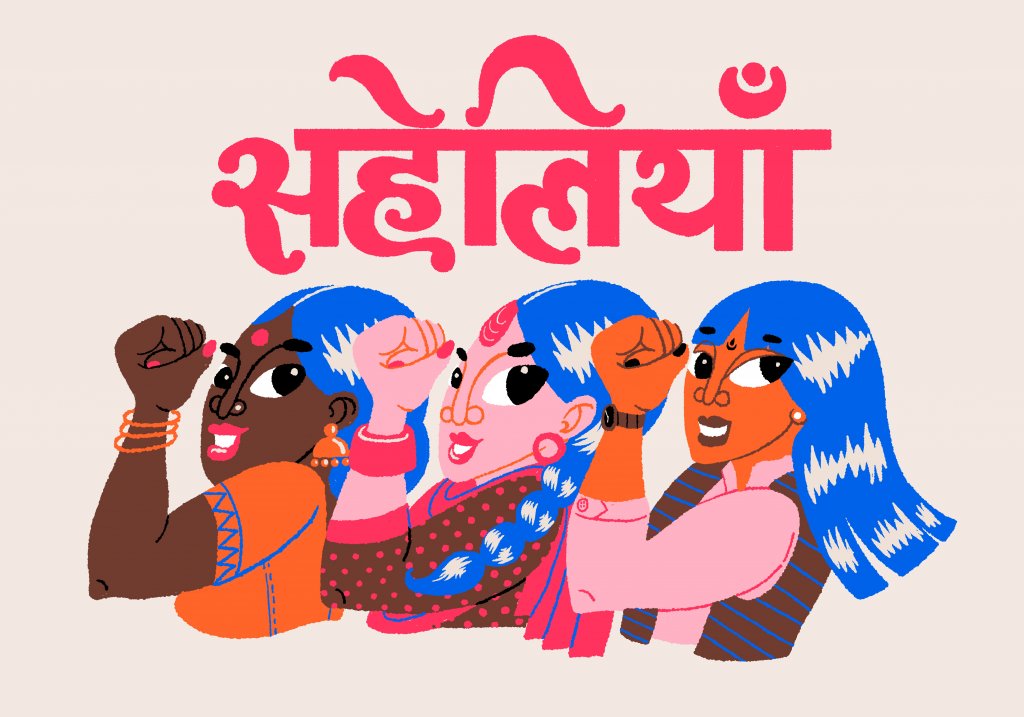
International Women’s Day ’19 | Snapchat
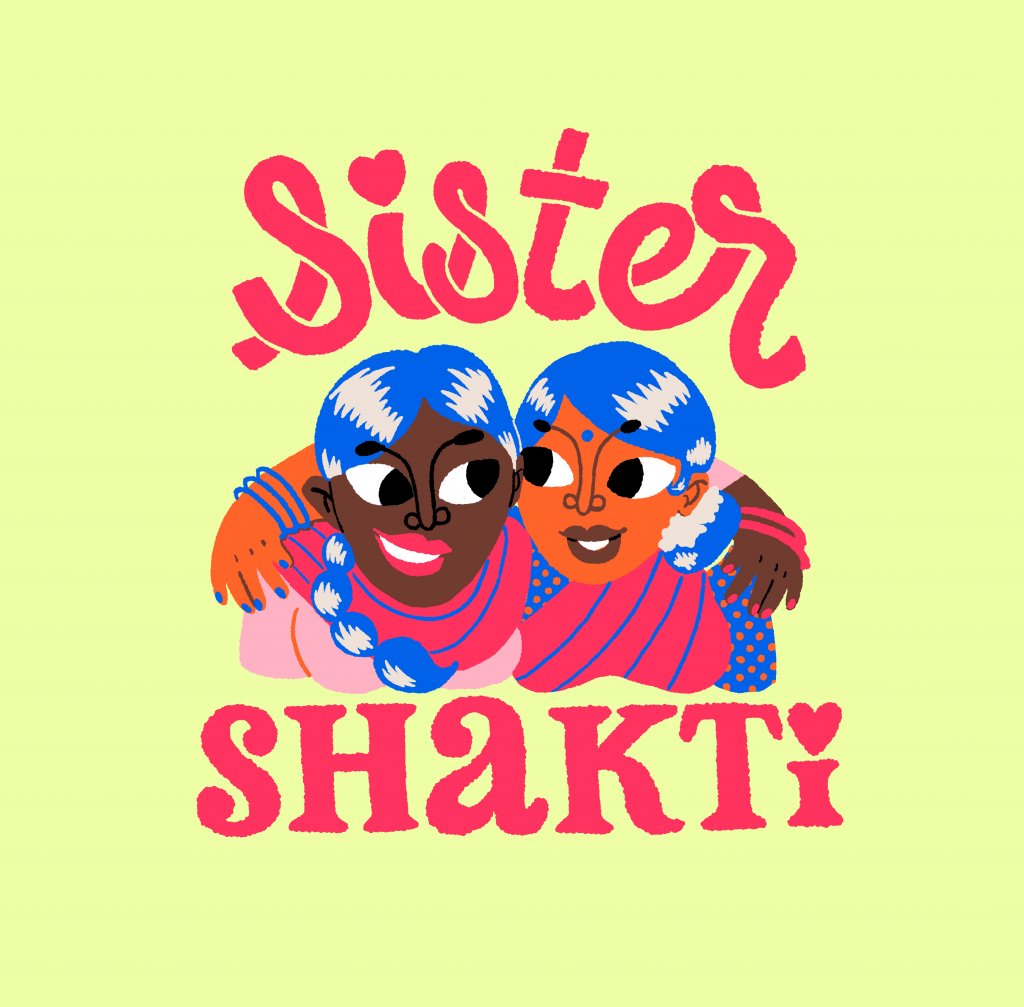
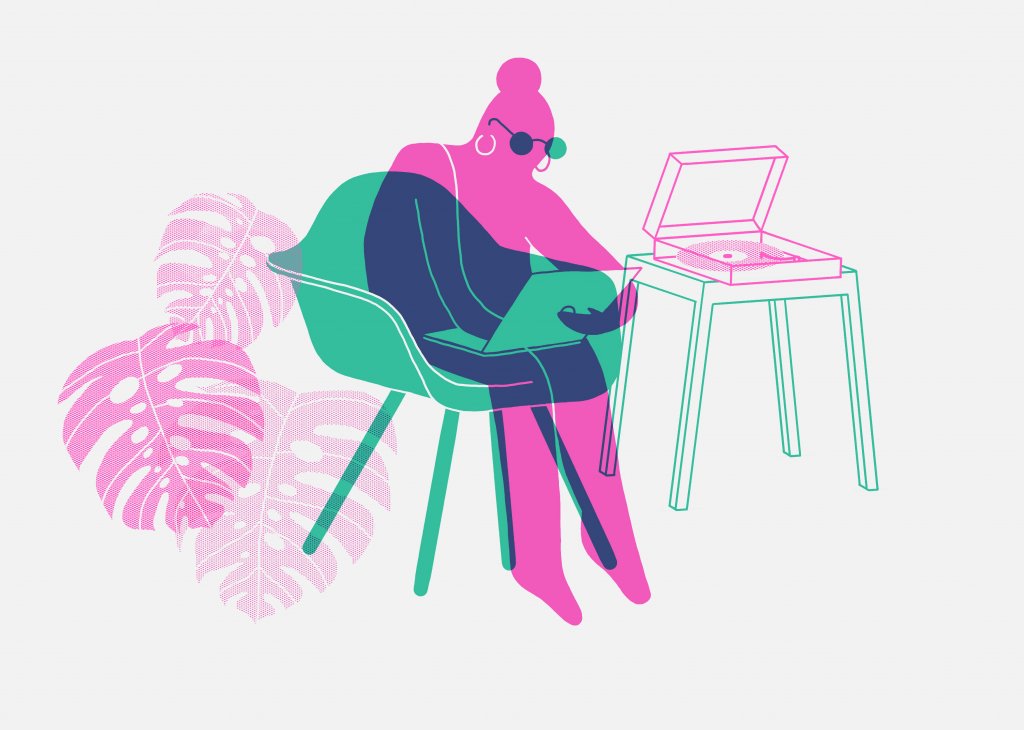
Illustration for JSW’s furniture brand Forma/ Commissioned by TFM Studio (that’s us!)
Mira's photographs are provided by her. ©
